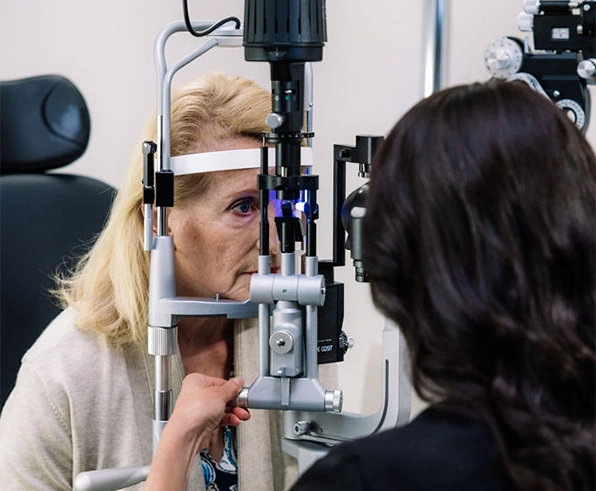
Selective Laser Trabeculoplasty
Selective Laser Trabeculoplasty
What is Selective Laser Trabeculoplasty?
Selective Laser Trabeculoplasty (SLT) is a minor eye operation done using a laser beam. It is among many methods to treat glaucoma, particularly open-angle glaucoma and ocular hypertension. SLT is done to decrease the pressure within your eyes, also known as intraocular pressure.
A laser beam is used to reshape the vulnerable structures, known as the trabecular meshwork, within the eye to relieve the increasing pressure inside the eyeball. A rise in intraocular pressure can cause glaucoma, resulting in blindness if not treated in time.

How Does Selective Laser Trabeculoplasty Work For Glaucoma?
The exact mechanism of action of Laser Trabeculoplasty is still not well understood. However, SLT has shown to be effective in treating open-angle glaucoma.
SLT targets selective pigment cells within the trabecular meshwork with a pulsating laser beam, usually Nd-YAG type. After which, the trabecular meshwork’s structural integrity undergoes remodeling.
It achieves its results by selectively absorbing the energy of the trabecular pigmented cells while sparing adjacent cells and tissues from thermal damage. SLT has been shown to cause less damage to the cells and has been found to enhance the outflow of the aqueous humour by biological and chemical modifications. It also has membrane repairing properties.
After the procedure, the aqueous humour can drain through this newly opened route, decreasing the intraocular pressure.

Who is a Candidate for Selective Laser Trabeculoplasty?
Selective Laser Trabeculoplasty is a minimally invasive procedure. As such, it is relatively safe and has fewer side effects. Anyone with persistently increased intraocular pressure with or without visual impairment can be a candidate. However, it is finally up to your doctor to decide whether or not you are a suitable candidate.
Generally, candidates for Selective Laser Trabeculoplasty are:
- People with newly diagnosed cases of Open-Angle Glaucoma.
- Open-Angle Glaucoma patients with uncontrolled intraocular pressure on medical treatment.
- Open-Angle Glaucoma patients with poor tolerance to medical treatment.
- Patients with pseudoexfoliation or pigmentary glaucoma and that with raised intraocular pressure.

What to Expect During Selective Laser Trabeculoplasty
Selective laser trabeculoplasty is an outpatient procedure, taking no more than 5 to 20 minutes. A special contact lens is applied to keep the eyelids open during the procedure. Anaesthetic eye drops are then applied to ensure that your eye is numb and that you feel no discomfort. A pupil dilating eye drop is also applied, following which your vision becomes blurry.
The laser machine looks similar to the microscope used to examine your eye. You might hear various beeping sounds during the process. The procedure itself is painless. Some patients may feel a little pressure within the eye, followed by a slight headache during or after the SLT procedure.
Once the procedure is completed, you may be asked to stay in the hospital for a few hours. This is done until topical anesthesia wears off and your vision becomes less blurry.
Usually, no additional medications are required after the procedure. However, further continuation or discontinuation of any ongoing medication is done per the doctor’s advice. Similarly, a doctor can prescribe eye drops for post-procedure care. A routine for regular follow-ups is made. During follow-ups, the doctor adjusts any medication as per the patient’s situation and progress.
After selective laser trabeculoplasty, you should avoid rubbing or vigorously washing your eyes, drinking alcohol, heavy lifting or exercises, smoking, and driving. It is also best to avoid any activity that requires extensive use of your eyes like stitching and working on a computer.
FAQs About Selective Laser Trabeculoplasty
Selective Laser Trabeculoplasty is an effective procedure to reduce intraocular pressure. The procedure takes anywhere between 5 to 20 minutes per eye. The signs of improvement to be seen vary from individual to individual. Some show improvement immediately, while for some, it can take months. A revisit for the procedure is expected usually in 3-5 years.
Although Selective Laser Trabeculoplasty is relatively a simple procedure, not everyone is eligible for it. Certain conditions where a Selective Laser Trabeculoplasty is contraindicated are listed below:
- Inflammatory, iridocorneal endothelial (ICE) syndrome
- Developmental and neovascular glaucoma
- Angle recession glaucoma due to distortion of the angle anatomy and trabecular meshwork scarring
- Inflammatory/uveitic glaucoma
- Poor visualisation of the trabecular meshwork
Any surgical intervention comes with its risk or side effects. Although Selective Laser Trabeculoplasty has been seen to be relatively safe and convenient procedure, some side effects have been reported. The most common side effect is a refractory rise in intraocular pressure. Other side effects that can occur are redness of eyes, foreign body sensation, corneal burns, and refractory bleeding.
Comparisons between selective laser trabeculoplasty and other modalities in treating the glaucoma have been made in multiple studies. The most significant comparison is between selective laser trabeculoplasty and argon laser trabeculoplasty. The study findings show similar outcomes between the two.
Selective laser trabeculoplasty was found to be significantly better in lowering intraocular pressure in cases where the procedure was repeated. Selective laser trabeculoplasty also had relatively lower risk of side effects and complications.
Comparisons have also been made between selective laser trabeculoplasty and other medical treatments for glaucoma. Selective laser trabeculoplasty had the advantage of being a one-time intervention not requiring ongoing patient compliance.
Its safety profile, effectiveness, and patient satisfaction has made selective laser trabeculoplasty the most preferred option for glaucoma treatment.
Selective laser trabeculoplasty is relatively less painful compared to other procedures. A numbing agent is applied topically to prevent any pain during the procedure. You might experience a slight stinging sensation or headaches after the procedure.
It is best not to consume alcohol 48 to 72 hours before any surgery. Although selective laser trabeculoplasty is a minor procedure, it is best to avoid alcohol consumption before the surgery. Alcohol consumption can complicate trivial matters and also interfere with the usual dosage of topical anesthesia required.
Although they sound similar, they are slightly different. Trabeculoplasty in simple terms means the repair of the trabecular meshwork whereas trabeculectomy refers to cutting and removing the trabecular meshwork.
Selective Laser Trabeculoplasty is a relatively safe and highly effective procedure with few side effects. The procedure is also relatively short and is done on an outpatient basis.
You should avoid driving after the surgery. Once the blurring of vision resolves and you have rested enough, you can start driving. However, the effects of medication can be seen up to the next 48 hours.
Your doctor will be the judge as to who is the best fit for the surgery. Generally, people with open-angle glaucoma and increased intraocular pressure are the best fit.
Specifically targeted cells known as pigmentary cells are selected by the laser. Since a specific cell type is usually targeted during the application of a laser beam and other cells are spared, it is called selective trabeculoplasty.
SLT is comparatively very effective to other treatment modalities. However, results can appear late for some individuals, and can take up to three months. The surgery is usually repeated after 4 to 5 years in most cases.
SLT generally lasts around 5 to 20 minutes. It is a relatively safe and minimally invasive procedure. After the procedure, you can do minor chores in the safety of your house with careful guidance. Once the blurring of vision improves, which can take up to 48 hours in some people, you are good to go on your own.
SLT stands for selective laser trabeculoplasty. It is a minor operation done to decrease the intraocular pressure. A laser beam is guided to make the outflow-tract work properly so that the intraocular pressure decreases.
SLT is safe, less time consuming and has fewer side effects. SLT also decreases the use of daily medications in most patients.
SLT is performed on an outpatient basis. The procedure is relatively short, taking from five to twenty minutes. A topical anesthetic eye drop is added, and a laser beam is guided to repair the trabecular meshwork.
Generally, you will not feel any pain. During the procedure, a special contact lens is applied to your eye. You will be given topical anesthetic eye drops. Therefore, the pain is usually not seen. However, post-operative headaches and a stinging sensation are commonly encountered.
Usually, patients require a follow-up surgery every three to five years. But, you will need to go for follow-ups as per the doctors’ instructions.
Patients start showing improvement immediately after the procedure. Your vision can improve following the surgery. However, for some, it may take a few months till significant improvement is observed.
This varies from person to person. Many do not require any further medication. A discussion with the doctor is necessary to conclude whether or not the medication is required.


Are You a Candidate for
Vision Correction?
Whether you just need a general eye exam, or if you are interested in reducing or eliminating your need for glasses or contacts, our team is here to help! Contact us to book an appointment today!


